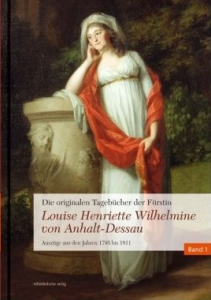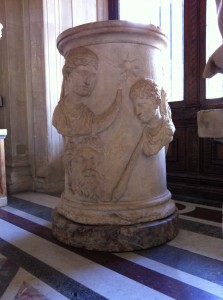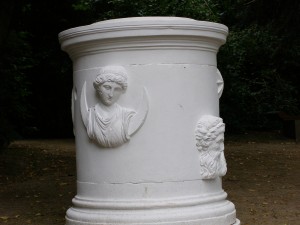There is a peculiar stand-alone altar in the gardens of Wörlitz, the famous early landscape garden laid out by the Von Anhalt-Dessau family from 1767 onwards. Standing near the kitchen building, close to the palace, it caught my eye when I visited the garden in 2009. The sides of the circular altar are dotted with reliefs of isolated figures, denoting the moon goddess Selene, Oceanos, some other figures and a few downward facing torches. It just seems a perfectly strange iconographic mix.
An altar as a weird conundrum, and as I thought at the time, quite unique.
 An altar similar to this takes a prominent place in a portrait of Louise Henriette Wilhelmine von Anhalt-Dessau, painted in 1799 (picture obviously taken from a book cover). But the proportions do not match – the real one is thicker and lower- and the figures on the painted altar are closer to each other. Also, the Selene that is visible on the painting is in a slightly different angle in comparison with the real altar I saw at Wörlitz.
An altar similar to this takes a prominent place in a portrait of Louise Henriette Wilhelmine von Anhalt-Dessau, painted in 1799 (picture obviously taken from a book cover). But the proportions do not match – the real one is thicker and lower- and the figures on the painted altar are closer to each other. Also, the Selene that is visible on the painting is in a slightly different angle in comparison with the real altar I saw at Wörlitz.
We could file those differences as the result of the artist’s freedom. But there are at least two of these altars, I found out during a visit to the Louvre earlier this year. In a statue gallery in the Roman sculpture section I saw the altar pictured below (with apologies for the image quality, there was not much light and I only had a phone at my disposal). 1Musee du Louvre (Inventaire MR 952, Nro usuel Ma 508); purchased by the museum in 1807. The museum is also in doubt with respect to the identity of the two young men.
 The Louvre altar shows more figures and in general has more in common with the painted Selene altar on Louise’s portrait. According to the museum’s information, the altar used to stand in the Diana Temple in the Villa Borghese gardens and there is a Ch. Percier drawing from 1790 mounted to the wall to prove that. The moon goddess Luna (Selene in Greek) and Diana were ultimately seen as similar figures, so the appearance of a 2nd century altar depicting Selene in a temple dedicated to Diana in a Renaissance garden is not particularly strange. 2The altar was purchased 17 years after the Percier drawing. At this moment a new Empire-style altar occupies the temple in Villa Borghese.
The Louvre altar shows more figures and in general has more in common with the painted Selene altar on Louise’s portrait. According to the museum’s information, the altar used to stand in the Diana Temple in the Villa Borghese gardens and there is a Ch. Percier drawing from 1790 mounted to the wall to prove that. The moon goddess Luna (Selene in Greek) and Diana were ultimately seen as similar figures, so the appearance of a 2nd century altar depicting Selene in a temple dedicated to Diana in a Renaissance garden is not particularly strange. 2The altar was purchased 17 years after the Percier drawing. At this moment a new Empire-style altar occupies the temple in Villa Borghese.
The altar at Wörlitz does not look like a roman example. More likely it is a neoclassical remake or pastiche of known examples such as the Borghese altar. It is hihgly likely that the owners of Wörlitz either visited the Borghese garden, or knew drawings or prints of the Temple of Diana.
It is obvious from the painting that the iconography was important for the family. But it would be nice to know for certain how this altar with this particular iconography came to adorn the majestic gardens of Wörlitz.
Footnotes
| ↑1 | Musee du Louvre (Inventaire MR 952, Nro usuel Ma 508); purchased by the museum in 1807. The museum is also in doubt with respect to the identity of the two young men. |
|---|---|
| ↑2 | The altar was purchased 17 years after the Percier drawing. At this moment a new Empire-style altar occupies the temple in Villa Borghese. |



